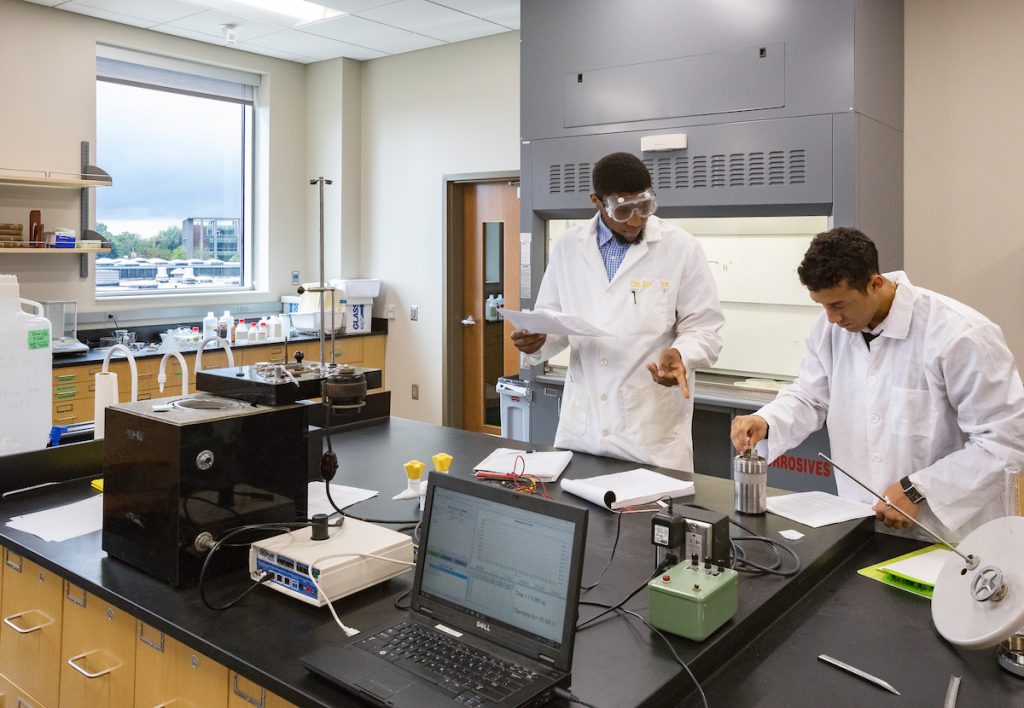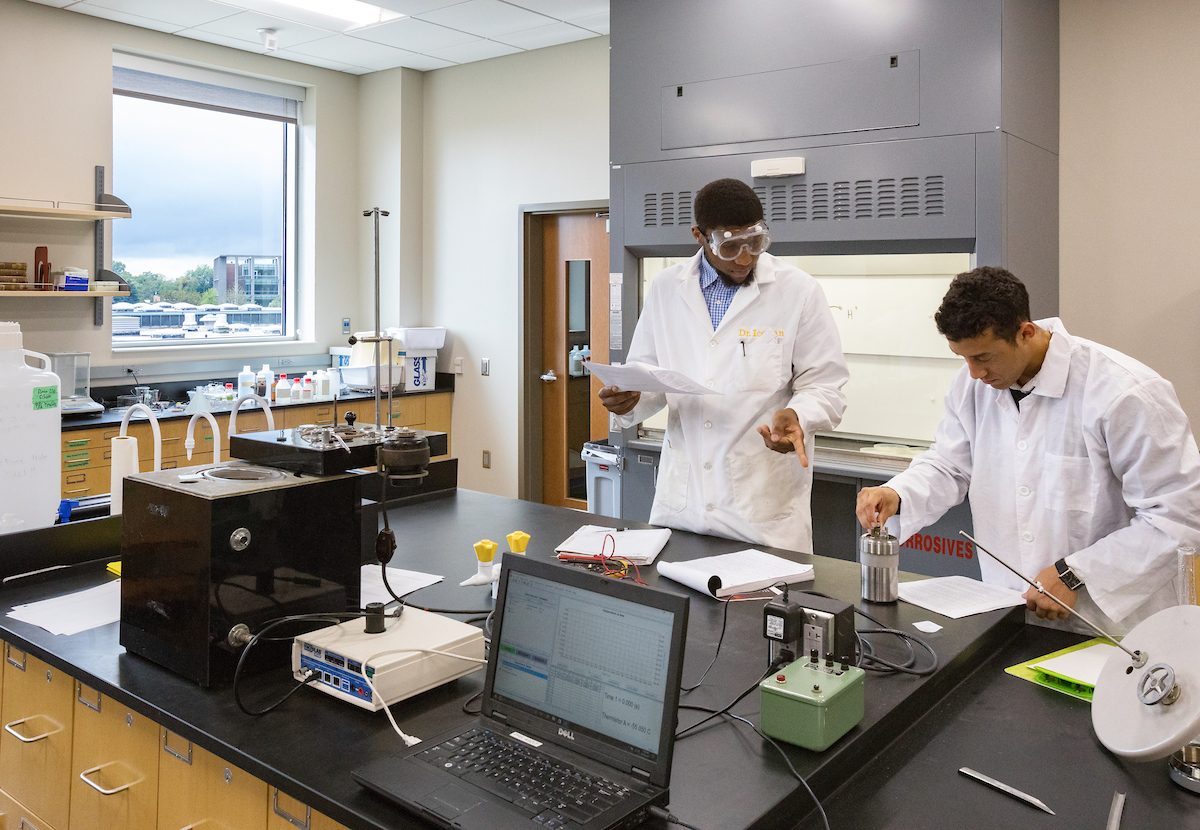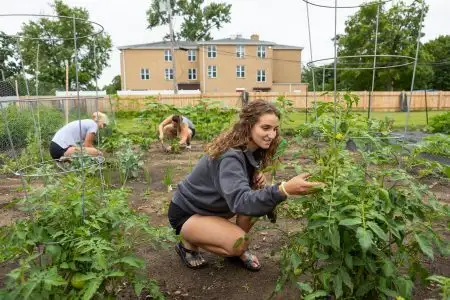Interdepartmental Cooperation Finding New Ways to Fight Sickness
Superbugs, antibacterial-resistant microorganisms that develop to defy some of our best medicines, have found their way to the International Space Station (ISS), hitching rides on humans and supplies and finding an environment almost totally free of competition. To combat these illness-causing microbes, new, novel compounds will need to be derived or synthesized, and that’s where Valparaiso University researchers are pitching in. Faculty and student researchers from the biology and chemistry departments are working together to find new ways of keeping illness in check for people on and off-planet.
“There are plenty of drugs already out there, but what happens is that you develop them, then in a couple of years you start detecting microbes that have developed a resistance to that drug,” says Jeffrey Pruet, Ph.D., associate professor of chemistry.
Pruet and Danielle Orozco-Nunnelly, Ph.D., associate professor of biology, have been awarded a $19,733 grant from the Indiana Space Grant Consortium (ISGC) — an organization funded by NASA — to identify and isolate novel compounds in medicinal plants used in traditional medicines and experiment with altering their structure to find the most effective forms. Professor Orozco-Nunnellly came to Valpo with one such plant in mind.
“After my Ph.D., I started working at a university in Mexico,” she says. “They told me about a plant there that had all of these interesting properties, but hadn’t really been explored.”
The plant, Argemone mexicana, has been largely absent from research labs due to the prevalence of synthetic antibiotics. As infectious microbes develop new resistances however, scientists are taking another look at natural medicines to keep the population healthy.
“The main benefit of natural over synthetic is that they’re just a huge resource of new, novel compounds that have antimicrobial properties that haven’t been explored,” says Professor Orozco-Nunnelly.
Upon arriving at Valpo, Professor Orozco-Nunnelly discovered that her colleague in chemistry, Professor Pruet, was doing very similar work from a biochemistry standpoint. The two have been working together ever since.
“It’s been a very lucrative collaboration,” says Professor Pruet. “We’ve gotten two Indiana Space Grant Consortium grants as well as internal funding from the University.”
Their collaboration has also opened numerous opportunities for student researchers. Seven will work under Professor Orozco-Nunnelly and three under Professor Pruet as they continue to break down, isolate, identify, and test various components of Argemone mexicana and beyond. A student from Ivy Tech Community College will also be hired to assist with the project and gain valuable experience.
The process of determining whether a compound has antibacterial action involves a number of steps. Professor Orozco-Nunnelly and her students create concentrated extracts from the leaves, stems, roots, flowers, and other parts of the plant and test to see what component has the most antimicrobial properties. They will also screen the 12 different microorganisms found on the ISS that they will be testing for, and maintain human cell cultures for testing.
Professor Pruet and his students take those extracts and break them down into isolated compounds through a process called column chromatography. Once isolated, student researchers can synthesize derivative molecules of those compounds to see what changes they can make to produce a greater or lesser effect. Those molecules are subjected to the Kirby-Bauer test, where the molecules are placed on a disc along with a sample of one of the microorganisms the researchers are focusing on combating. Eventually, a “halo” forms around the antimicrobial molecule where bacteria can get no closer. A larger halo can mean the synthesized molecule is having a greater effect.
In addition to Argemone mexicana, Valparaiso University has also recently began growing a medicinal garden to raise other plants known by various traditions to contain healing properties. As part of the current grant, faculty and student researchers will begin replicating the examination processes with a wider variety of samples in the hopes of finding more antimicrobial compounds.
The project is still in the early stages of a traditional drug development process, and it is too early to know what kind of impact these tests could have on medicine, but there are tentatively hopeful signs.
“We’ve started to discover some pretty promising molecules that are better than the plant-derived source, so that’s a big jump in the right direction,” says Professor Pruet.
Should a molecule be discovered with potential for widespread medicinal use, Valpo researchers could apply for a patent, publish their findings, then enlist the partnership of a larger institution with more resources to perform Federal Drug Administration and clinical trials. All of these stages, however, may be a long way off and depend on what researchers discover.
For the students involved, getting the opportunity to put real research on their resumes as undergraduates could have a major impact on their future education and careers.
“I think it will be very useful,” says Professor Orozco-Nunnelly. “Medical and graduate schools look for research experience, and some of these students have been co-authors in the past.”
A previous group working on this research produced an academic paper with three undergraduate students listed as co-authors, and a new paper is in the works with six.
“Having a publication on the record as a co-author will be great for them, moving on,” says Professor Orozco-Nunnelly.
The project is also an example of the kind of cross-disciplinary work that exists between departments at Valparaiso University. According to Professor Orozco-Nunnelly, many of the students are going back and forth between biology and chemistry labs, getting first hand looks at the kind of work their future co-workers may be engaged in. It is also a fantastic example of supporting the kind of learning opportunities that make up one of the four main pillars of Uplift Valpo: Our Beacon for the Journey Forward, the University’s five-year strategic plan.
For more information on the departments involved, visit valpo.edu/biology and valpo.edu/chemistry.


